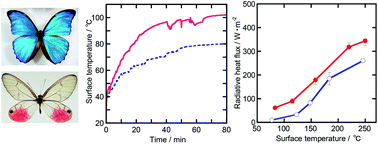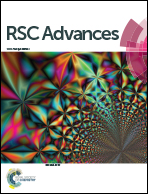Heat transfer properties of Morpho butterfly wings and the dependence of these properties on the wing surface structure†
Abstract
The heat transfer properties of a material strongly rely on its surface structure. The wings of the Morpho butterfly have a unique surface structure with features of order and disorder. In this work, the surface temperature and radiative heat flux of Morpho butterfly wings with structural colour when a ceramic heater attached to the opposite surface of the wings was heated to 250 °C were evaluated in terms of their heat transfer properties. Morpho menelaus butterfly (MM) wings and Cithaerias (CE) wings with no periodic structure on their surface, were used as samples. The MM wings had higher surface temperature and radiative heat flux than the CE wings, which is the first report of heat transfer properties of the wings. The surface structure of the MM wings was changed by heat treatment in order to investigate the effect of the surface structural change on their heat transfer properties. The treatment changed the colour of the wings to red and brown, distorting the periodic structure. The radiative heat flux increased due to the change in the structure on their surface. XPS spectra revealed that the treatment leads to a slight change in the chemical structure of the wings. The spectral analyses results showed there was no obvious change in the mid-infrared absorbance. The heat radiative properties of the MM wings were strongly influenced by the surface structural changes due to the heat treatment.



 Please wait while we load your content...
Please wait while we load your content...